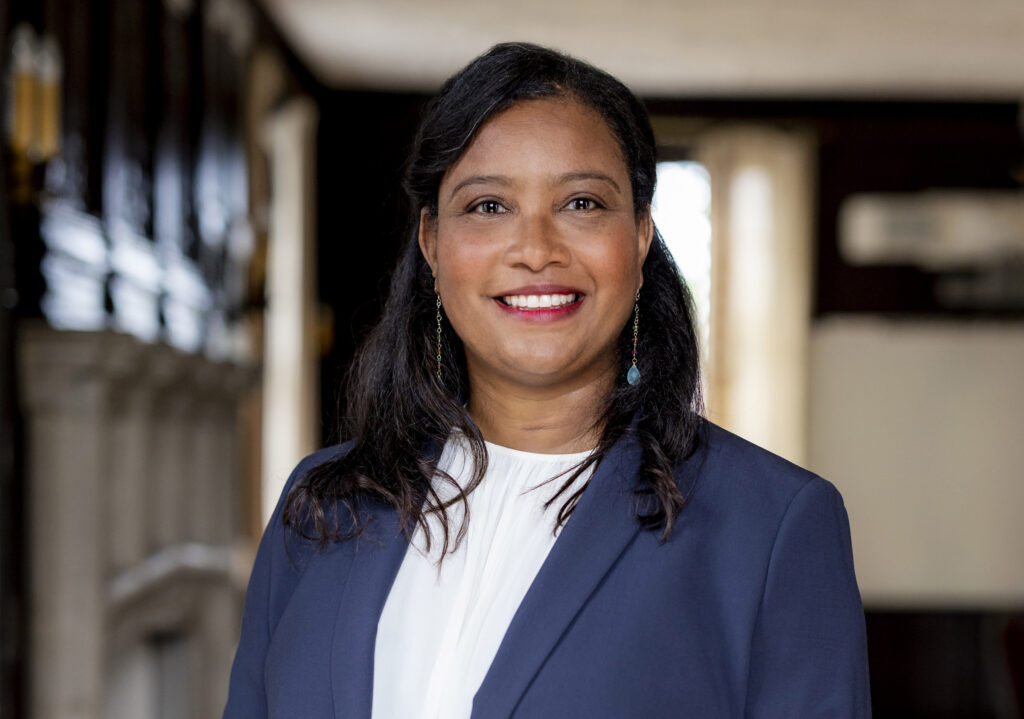Boston College Law School Professor Lisa Alexander’s work sits at the intersection of housing, equity, and imagination. From her upbringing in publicly subsidized housing in New York City to her scholarship on tiny homes and alternative property systems, she explores how law both shapes and reflects who gets to belong, and benefit from property law. In this conversation, she speaks about her path into housing law, the social creativity of tiny home movements, and why the future of legal education must take housing seriously.
Q: You have described growing up in publicly subsidized housing in New York and how that shaped your early curiosity about who gets to live where, and why. How has that personal background evolved into your lifelong scholarly focus on equitable housing policy?
Alexander: I grew up in what New York calls Mitchell–Lama housing. It was a state program, started in 1955, to create affordable homes for working-class families: teachers, firefighters, people like my parents. The housing was privately owned but publicly subsidized through tax breaks, allowing rents to remain affordable.
Our building sat in Manhattan, not far from traditional public housing. I noticed from a young age how my building was nicer than public housing, but still worlds away from the homes of classmates I met at a private school on the East Side, children whose families owned large co-ops or townhouses. It made me wonder: Why do some people live in buildings like mine, some in public housing, and some in wealthy homes?
That curiosity turned into a lifelong question about how housing determines life outcomes. I wanted to understand why certain groups had access to ownership and others did not, and how law structured those inequities.
When I went to law school, I initially thought I would be a litigator because that was how I understood justice happened. You sued people, you went to court, you fought it out, like in the civil rights movement. However, I then discovered housing and community development law, which was an emerging field at the time. I realized that advancing equity required not only litigation but also transactional and corporate skills because affordable housing was increasingly built through public-private partnerships.
As a result, I immersed myself in real estate and transactional law, seeing those as tools to help underserved communities and advance racial justice. That trajectory shaped the way I teach now: I teach courses in Housing Law and Policy, Corporations, and Local Government Law because cities and private systems are where housing law truly lives.
Q: For you, the tiny house is not just about downsizing or minimalism; it is also about dignity and agency. What do you think the movement reveals about how Americans define “home” today?
Alexander: The tiny house movement fascinates me because it shows how people define home in ways that do not always match the law’s categories. In property law, we have rigid definitions of ownership and tenancy, but formerly unhoused people living in tiny homes are asserting a kind of legal consciousness, a belief in their right to space and belonging, that sometimes operates outside formal legal recognition.
In my Minnesota Law Review article, “Community in Property: Lessons From Tiny Homes Villages,” I studied pre-pandemic tiny home villages where residents did not just live in or rent their homes: they built them, stored them, maintained them, and governed them. That stewardship process gave people, many of whom had been unhoused or socially disconnected, a chance to realize their dignity and self-determination.
There is a dominant narrative that people experiencing homelessness are passive or broken. But in these communities, residents demonstrated agency: they designed homes, solved local problems, and created self-governing systems when cities could not. The tiny home movement for unhoused individuals challenged stereotypes by demonstrating that dignity and productivity can thrive even outside traditional housing markets.
Q: You have previously written that the legal system often lags behind innovation at the community level. What does that look like in the tiny home space, and what changes would make law a better partner to social creativity?
Alexander: Many building codes still define a “dwelling” as at least 400 square feet, a rule rooted in historical concerns about unsafe shanties. But tiny homes deliberately shrink the footprint of housing while improving sustainability and affordability. They force us to rethink what a “safe and habitable” dwelling looks like.
Some of the most promising legal innovations have come from cities that redefine dwelling units or create new categories entirely. One approach is legalizing Accessory Dwelling Units (ADUs): small homes on lots that already have a main dwelling, sometimes called “granny flats” or “backyard cottages.” These allow people to build smaller, secondary homes legally.
Another is to create specific ordinances for tiny home villages; for example, Seattle recognizes small, temporary dwellings for unhoused individuals as legal emergency housing. These steps legitimize what communities were already doing and prevent police “sweeps” that destroy informal shelters.
Just as important are community governance models. Many tiny home villages write their own rules for participation and maintenance, fostering self-governance and accountability. Cities could provide model bylaws to guide these efforts, making law a partner in social creativity rather than a barrier.
Q: Notably, the tiny home movement has also been propelled by real estate developers, faith groups, and nonprofits. Are there particular organizations, experts, or partnerships leading the way in integrating housing equity with sustainable design?
Alexander: Yes, several. SquareOne Villages, based in Oregon, is a nonprofit that helps communities design and manage cooperative tiny home villages. They provide technical assistance and planning guidance, especially across the West Coast.
Another is Mobile Loaves & Fishes, a faith-based organization in Austin, Texas. They began by delivering meals to unhoused individuals and later created Community First! Village, a massive development of tiny homes providing permanent supportive housing. It is now one of the largest of its kind in the country, with thousands of residents.
Both examples show what is possible when nonprofits, cities, and community members combine sustainable design with equity-centered governance.
Q: You have also observed how cities that once resisted these ideas, from Portland to Austin, have started to embrace them. How are local governments learning to see tiny home villages as part of the broader affordable housing ecosystem?
Alexander: The most receptive cities have been on the West Coast, especially within the Ninth Circuit, where housing costs and homelessness have reached crisis levels. The growth of the tech industry intensified inequality in places like Seattle, San Francisco, and Los Angeles.
To respond, many adopted the Housing First model, prioritizing stable housing before addressing issues such as addiction or unemployment. Tiny homes became a practical extension of that philosophy: inexpensive, fast to build, and adaptable.
Legal pressure also played a role. In Martin v. Boise (2018), the Ninth Circuit held that criminalizing people for sleeping outdoors when no shelter was available violated the Eighth Amendment. Cities suddenly faced constitutional obligations to provide alternatives. Tiny homes offered one solution.
Although the US Supreme Court later overturned that precedent in Grants Pass v. Johnson, many cities have continued their programs. They have seen that these villages are not only humane but also cost-effective ways to stabilize communities while longer-term housing is developed.
Q: When you think about housing rights in the US, what new paradigms are emerging? Do you see tiny houses as a stepping stone toward a broader redefinition of property or ownership?
Alexander: In my Minnesota Law Review article “Community in Property,” I wrote about how some tiny home villages reveal a new form of tenure, I call stewardship: something besides owning and renting.
In many communities, residents do not pay rent in the traditional sense. Instead, they contribute “sweat equity”: maintaining their home, following community rules, and helping to build others’ homes. They hold a right to occupy and exclude others, but not through deeds or leases. That is a stewardship model of property.
It challenges the old legal categories inherited from feudal England, built for an agrarian society where land was abundant and labor was tied to ownership. Today, with climate change, limited space, and deep inequality, those categories no longer serve us well.
We need a broader range of housing tenures, forms that reflect sustainability and equity. My work on tiny homes, long-term tenants, and even hip-hop and housing all explores how people are reshaping property law from below, asserting new rights to home and community beyond what the law currently recognizes.
Q: Your Harvard Law & Policy Review article examines tiny houses through the lens of housing justice. What central argument do you hope readers take from it?
Alexander: That article came out around the pandemic, when cities faced overlapping crises of eviction, disaster, and affordability. I argued that tiny homes can be a rapid, humane tool for addressing these emergencies. Cities could deploy them after natural disasters, to relieve housing shortages, or as transitional options during mass displacement.
But I also warned that legalization must come with safeguards against exploitation. Historically, unregulated small housing (e.g., shanties, rooming houses, company shacks, etc.) left people vulnerable. If we adapt codes to allow tiny homes, we must also ensure they meet habitability standards and are not used for profit-driven abuse.
Ownership structures matter too. If only private developers control these communities, they risk replicating the inequities of manufactured housing parks. Cities and nonprofits need to co-govern, with oversight and resident participation, to ensure these spaces stay just and sustainable.
In short, innovation must be paired with accountability. Tiny homes can promote justice only if their legal design centers dignity and self-determination.
Q: The Tiny House Movement has roots in environmentalism but has grown into something more socially complex. What can environmental sustainability and housing justice learn from each other?
Alexander: Historically, the environmental movement focused on preservation and keeping land untouched. That is valuable, but it can conflict with housing justice when people need places to live. The newer climate justice approach recognizes that environmental and social sustainability are inseparable.
We have seen what happens when development follows profit alone: housing built in floodplains, near rising seas, or in areas without adequate infrastructure, all for quick returns to investors. Too often, low-income people and people of color are pushed into those vulnerable zones.
So environmental and housing justice must evolve together. Sustainable design should mean not only using green materials but also protecting people, ensuring homes are affordable, safe, and resilient. Even emerging issues, such as the energy demands of AI infrastructure, raise questions about where and how we build.
If we want genuine sustainability, we have to balance ecological health with human flourishing. Housing justice is environmental justice.
Q: When you think about the future of housing, what role do you hope law schools, and your students at Boston College Law School in particular, will play in making more inclusive communities possible?
Alexander: I want students to understand that housing law is central to justice, not peripheral. It is often treated as technical or secondary, but it shapes everything: opportunity, wealth, even democracy.
Housing affordability is now a national crisis. Addressing it requires an expansive set of legal skills (including litigation, real estate transactions, tax, land use, and local government) and an interdisciplinary mindset. Lawyers need to work with architects, engineers, environmental scientists, and community organizers.
I also want students in general, and students of color in particular, to understand that justice is not only achieved through constitutional or criminal law. Transactional and property law can also serve as powerful tools for achieving equity and reparative justice. You can make a living as a real estate lawyer and still serve your community.
Ultimately, I want future lawyers to see housing as a site of imagination: a place where law can literally build the world we want to live in.


